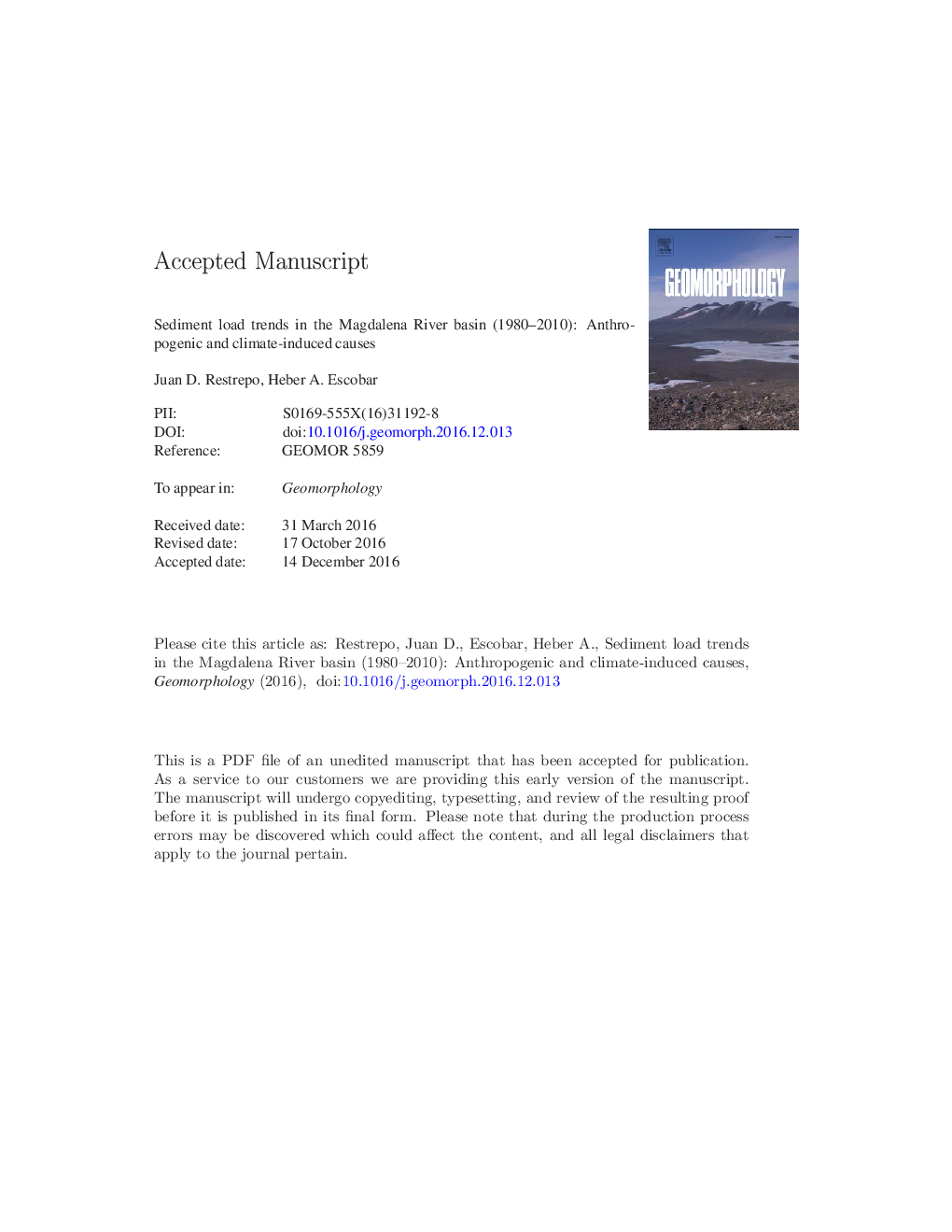| کد مقاله | کد نشریه | سال انتشار | مقاله انگلیسی | نسخه تمام متن |
|---|---|---|---|---|
| 8908266 | 1635348 | 2018 | 45 صفحه PDF | دانلود رایگان |
عنوان انگلیسی مقاله ISI
Sediment load trends in the Magdalena River basin (1980-2010): Anthropogenic and climate-induced causes
ترجمه فارسی عنوان
روندهای بارگیری رسوب در حوضه رودخانه مگالدینا (1980-2010): علل ناشی از انسانیت و آب و هوا
دانلود مقاله + سفارش ترجمه
دانلود مقاله ISI انگلیسی
رایگان برای ایرانیان
کلمات کلیدی
رود مگدالنا، روند بار رسوب، بارش، تاثیرات انسانی،
موضوعات مرتبط
مهندسی و علوم پایه
علوم زمین و سیارات
فرآیندهای سطح زمین
چکیده انگلیسی
The Colombian Andes and its main river basin, the Magdalena, have witnessed dramatic changes in land cover and further forest loss during the last three decades. For the Magdalena River, human activities appear to have played a more prominent role compared to rainfall (climate change) to mobilize sediment. However, environmental authorities in Colombia argue that climate change is the main trigger of erosion and floods experienced during the last decade. Here we present the first regional exercise addressing the following: (1) what are the observed trends of sediment load in the northern Andes during the last three decades? and (2) are sediment load trends in agreement with tendencies in land use change and climate (e.g., precipitation)? We perform Mann-Kendall tests on sediment load series for 21 main tributary systems during the 1980-2010 period. These gauging stations represent 77% of the whole Magdalena basin area. The last decade has been a period of increased pulses in sediment transport as seen by the statistical significant trends in load. Overall, six subcatchments, representing 55% of the analyzed Magdalena basin area, have witnessed increasing trends in sediment load. Also, some major tributaries have experienced changes in their interannual mean sediment flux during the mid- 1990s and 2005. Further analysis of land cover change (e.g., deforestation) indicates that the basin has undergone considerable change. Forest cover decreased by 40% over the period of study, while the area under agriculture and pasture cover (agricultural lands 1 and 2) increased by 65%. The highest peak of forest loss on record in the Magdalena basin, 5106 km2 or 24% of the combined deforestation in Colombia, occurred during the 2005-2010 period. In contrast, Mann-Kendall tests on rainfall series for 61 stations reveal that precipitation shows no regional signs of increasing trends. Also, increasing trends in sediment load match quite well with the marked increase in forest clearance during the 1990-2000 and 2005-2010 periods. Such signs of increasing sediment fluxes should not be attributed to climate change and rainfall variability alone. As a whole, the Magdalena, one of the top 10 rivers in terms of sediment delivery to the ocean (184 Mt yâ 1), and its tributaries have experienced increasing trends in sediment load during the 1980-2010 period; increases in close agreement with trends in land use change and deforestation. During the last decade, the Magdalena River drainage basin has witnessed an increase in erosion rates of 34%, from 550 t kmâ 2 yâ 1 before 2000 to 710 t kmâ 2 yâ 1 for the 2000-2010 period, and the average sediment load for the whole basin increased to 44 Mt yâ 1 for the same period. Similar to the global picture of human contribution to sediment generation, the rate of anthropogenic soil erosion in the Magdalena basin probably exceeds the rate of climate-driven erosion by several orders of magnitude.
ناشر
Database: Elsevier - ScienceDirect (ساینس دایرکت)
Journal: Geomorphology - Volume 302, 1 February 2018, Pages 76-91
Journal: Geomorphology - Volume 302, 1 February 2018, Pages 76-91
نویسندگان
Juan D. Restrepo, Heber A. Escobar,
